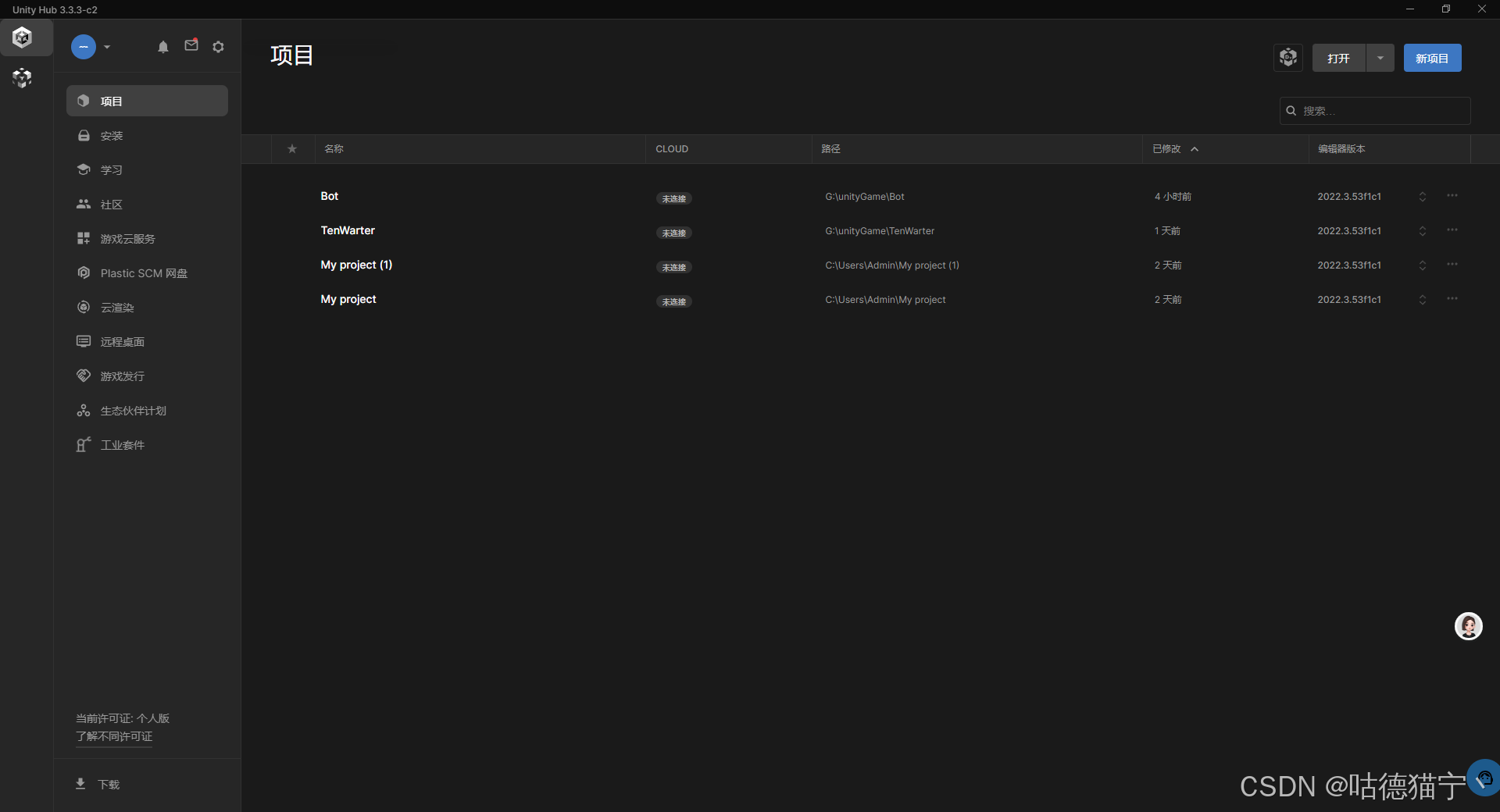
Unity引擎开发:Unity基础入门_Unity性能优化
通过合理地管理资源、优化场景、脚本和渲染,以及使用性能分析工具,可以显著提升 Unity 游戏的性能。希望本节内容能够帮助你在开发过程中更好地进行性能优化,确保游戏在各种设备上都能流畅运行。
Unity性能优化
在游戏开发中,性能优化是一个至关重要的环节。一个流畅、高效的游戏不仅能够提升玩家的体验,还能确保游戏能够在各种设备上顺利运行。Unity 引擎提供了多种工具和方法来帮助开发者优化游戏的性能。本节将详细介绍 Unity 中的性能优化技术,包括资源管理、场景优化、脚本优化、渲染优化等方面的内容。
资源管理
资源管理是性能优化的基础。合理地管理资源可以显著提升游戏的加载速度和运行效率。以下是一些常见的资源管理技巧:
1. 使用 AssetBundles
AssetBundles 是 Unity 提供的一种资源打包方法,可以将资源文件打包成独立的文件,以便在运行时动态加载。这不仅可以减少初始加载时间,还可以节省内存。
步骤:
-
创建 AssetBundle。
-
打包资源。
-
加载和卸载 AssetBundle。
示例:
using UnityEngine;
using System.Collections;
public class AssetBundleManager : MonoBehaviour
{
// 1. 创建 AssetBundle
[MenuItem("Assets/Build AssetBundles")]
static void BuildAssetBundles()
{
string assetBundleDirectory = Application.streamingAssetsPath + "/AssetBundles";
if (!System.IO.Directory.Exists(assetBundleDirectory))
{
System.IO.Directory.CreateDirectory(assetBundleDirectory);
}
BuildPipeline.BuildAssetBundles(assetBundleDirectory, BuildAssetBundleOptions.None, BuildTarget.StandaloneWindows);
}
// 2. 加载 AssetBundle
IEnumerator LoadAssetBundle()
{
string filePath = System.IO.Path.Combine(Application.streamingAssetsPath, "AssetBundles/mybundle");
UnityWebRequest www = UnityWebRequestAssetBundle.GetAssetBundle(filePath);
yield return www.SendWebRequest();
if (www.isNetworkError || www.isHttpError)
{
Debug.LogError(www.error);
}
else
{
AssetBundle bundle = DownloadHandlerAssetBundle.GetContent(www);
GameObject prefab = bundle.LoadAsset<GameObject>("MyPrefab");
Instantiate(prefab);
}
}
// 3. 卸载 AssetBundle
public void UnloadAssetBundle()
{
string filePath = System.IO.Path.Combine(Application.streamingAssetsPath, "AssetBundles/mybundle");
AssetBundle bundle = AssetBundle.LoadFromFile(filePath);
bundle.Unload(true); // true 表示卸载所有资源,false 表示仅卸载未使用的资源
}
}
解释:
-
BuildAssetBundles方法用于创建 AssetBundles,路径为Application.streamingAssetsPath + "/AssetBundles"。 -
LoadAssetBundle方法使用UnityWebRequest动态加载 AssetBundle,并从中加载预制体。 -
UnloadAssetBundle方法用于卸载 AssetBundle,释放内存。
场景优化
场景优化可以显著提升游戏的运行效率。以下是一些常见的场景优化技巧:
1. 使用 LOD (Level of Detail)
LOD 技术可以根据物体与摄像机的距离动态地调整模型的详细程度,从而减少不必要的计算。
示例:
-
在 Unity 编辑器中,选择要使用 LOD 的模型。
-
在 Inspector 窗口中,点击 “Add Component” 并选择 “LOD Group”。
-
配置 LOD Group,添加不同详细程度的模型。
using UnityEngine;
public class LODExample : MonoBehaviour
{
private LODGroup lodGroup;
void Start()
{
lodGroup = GetComponent<LODGroup>();
if (lodGroup == null)
{
Debug.LogError("LODGroup component not found!");
}
}
void Update()
{
// 根据玩家与模型的距离调整 LOD
float distance = Vector3.Distance(Camera.main.transform.position, transform.position);
lodGroup.RecalculateBounds();
lodGroup.RecalculateViewDistance(distance);
}
}
解释:
-
LODGroup组件用于管理模型的 LOD。 -
RecalculateBounds和RecalculateViewDistance方法用于根据摄像机的距离动态调整 LOD。
2. 使用 Occlusion Culling
Occlusion Culling 技术可以自动检测并剔除不在摄像机视野中的物体,从而减少渲染开销。
步骤:
-
在 Unity 编辑器中,点击 “Window” -> “Lighting” -> “Lighting Settings”。
-
在 Lighting 窗口中,启用 Occlusion Culling。
-
选择需要进行 Occlusion Culling 的场景物体。
-
点击 “Generate Lighting” 生成 Occlusion Culling 数据。
示例:
using UnityEngine;
public class OcclusionCullingExample : MonoBehaviour
{
void Start()
{
// 检查 Occlusion Culling 是否启用
if (!PlayerSettings.enableOcclusionCulling)
{
Debug.LogError("Occlusion Culling is not enabled!");
}
}
}
解释:
PlayerSettings.enableOcclusionCulling用于检查 Occlusion Culling 是否启用。
脚本优化
脚本优化可以显著提升游戏的逻辑处理速度。以下是一些常见的脚本优化技巧:
1. 避免频繁的垃圾回收
频繁的垃圾回收会严重影响游戏的性能。通过减少临时对象的创建,可以有效避免垃圾回收的频繁发生。
示例:
using UnityEngine;
public class AvoidGarbageCollection : MonoBehaviour
{
private string[] messages = new string[10];
private int messageIndex = 0;
void Update()
{
// 避免使用 string + 操作
messages[messageIndex] = "Message " + messageIndex;
messageIndex = (messageIndex + 1) % 10;
// 使用 StringBuilder
System.Text.StringBuilder sb = new System.Text.StringBuilder();
for (int i = 0; i < 10; i++)
{
sb.Append(messages[i] + " ");
}
string finalMessage = sb.ToString();
Debug.Log(finalMessage);
}
}
解释:
- 使用
StringBuilder而不是string +操作,可以减少临时字符串对象的创建,从而避免垃圾回收。
2. 使用协程优化更新频率
协程可以用于优化某些需要频繁更新的逻辑,特别是当这些逻辑不需要每一帧都执行时。
示例:
using UnityEngine;
public class CoroutineOptimization : MonoBehaviour
{
void Start()
{
StartCoroutine(UpdateEverySecond());
}
IEnumerator UpdateEverySecond()
{
while (true)
{
// 每隔一秒执行一次
yield return new WaitForSeconds(1.0f);
Debug.Log("Updating every second");
}
}
}
解释:
-
StartCoroutine方法用于启动协程。 -
yield return new WaitForSeconds(1.0f)使协程每隔一秒执行一次,减少更新频率。
渲染优化
渲染优化是性能优化的重要部分。以下是一些常见的渲染优化技巧:
1. 使用批处理 (Batching)
批处理可以减少绘制调用的次数,从而提升渲染性能。Unity 提供了静态批处理和动态批处理两种方式。
示例:
-
启用静态批处理:
-
选择需要静态批处理的物体。
-
在 Inspector 窗口中,勾选 “Static” 标记。
-
-
启用动态批处理:
-
确保所有动态物体使用相同的材质。
-
保持网格顶点数量在 900 以下。
-
using UnityEngine;
public class BatchingExample : MonoBehaviour
{
void Start()
{
// 检查批处理是否启用
if (!PlayerSettings.staticBatching || !PlayerSettings.dynamicBatching)
{
Debug.LogError("Batching is not enabled!");
}
}
}
解释:
PlayerSettings.staticBatching和PlayerSettings.dynamicBatching用于检查静态批处理和动态批处理是否启用。
2. 使用光照探针 (Light Probes)
光照探针可以用于优化光照效果,特别是对于移动物体。通过使用光照探针,可以减少实时计算光照的开销。
示例:
-
在 Unity 编辑器中,选择需要使用光照探针的物体。
-
在 Inspector 窗口中,点击 “Add Component” 并选择 “Light Probe Group”。
-
配置光照探针组,添加光照探针点。
using UnityEngine;
public class LightProbesExample : MonoBehaviour
{
private Renderer renderer;
void Start()
{
renderer = GetComponent<Renderer>();
if (renderer == null)
{
Debug.LogError("Renderer component not found!");
}
}
void Update()
{
// 更新光照探针
renderer.probeAnchor = transform;
}
}
解释:
-
Renderer组件用于管理物体的渲染属性。 -
probeAnchor属性用于指定光照探针的锚点,确保移动物体使用正确的光照效果。
网络优化
网络优化在多人游戏和在线游戏中尤为重要。以下是一些常见的网络优化技巧:
1. 使用 Unity 的网络传输系统
Unity 提供了多种网络传输系统,如 Unity Transport、MLAPI 等。合理选择和配置网络传输系统可以显著提升网络性能。
示例:
-
安装 MLAPI 插件。
-
配置网络管理器。
using UnityEngine;
using MLAPI;
using MLAPI.NetworkedMonoBehaviour;
public class NetworkOptimization : NetworkedMonoBehaviour
{
[SerializeField] private string playerName;
public override void NetworkStart()
{
base.NetworkStart();
Debug.Log($"Player {playerName} has joined the game.");
}
public void SendMessageToServer(string message)
{
if (IsLocalPlayer)
{
// 发送消息到服务器
SendClientRpcMessage(message);
}
}
[ClientRpc]
public void SendClientRpcMessage(string message)
{
Debug.Log($"Player {playerName} sent message: {message}");
}
}
解释:
-
NetworkedMonoBehaviour是 MLAPI 提供的网络行为基类。 -
NetworkStart方法在网络对象启动时调用。 -
SendMessageToServer方法用于发送消息到服务器。 -
SendClientRpcMessage方法是 ClientRpc 方法,用于将消息从客户端发送到服务器。
2. 优化网络消息
合理地优化网络消息的大小和频率可以显著提升网络性能。通过减少不必要的消息传输,可以降低网络带宽的使用。
示例:
using UnityEngine;
using MLAPI;
using MLAPI.NetworkedMonoBehaviour;
public class NetworkMessageOptimization : NetworkedMonoBehaviour
{
[SerializeField] private float syncInterval = 0.5f;
private float lastSyncTime = 0.0f;
void Update()
{
if (IsLocalPlayer && Time.time - lastSyncTime > syncInterval)
{
SyncPosition();
lastSyncTime = Time.time;
}
}
public void SyncPosition()
{
if (IsLocalPlayer)
{
// 发送位置同步消息
SendPositionToServer(transform.position);
}
}
[ClientRpc]
public void SendPositionToServer(Vector3 position)
{
transform.position = position;
}
}
解释:
-
syncInterval用于控制位置同步的频率。 -
SyncPosition方法用于发送位置同步消息。 -
SendPositionToServer方法是 ClientRpc 方法,用于将位置从客户端发送到服务器。
性能分析工具
Unity 提供了多种性能分析工具,帮助开发者找到性能瓶颈并进行优化。以下是一些常用的性能分析工具:
1. Unity Profiler
Unity Profiler 是一个强大的性能分析工具,可以查看 CPU、GPU、内存等多方面的性能数据。
步骤:
-
在 Unity 编辑器中,点击 “Window” -> “Analysis” -> “Profiler”。
-
在 Profiler 窗口中,选择需要分析的性能指标。
-
运行游戏并观察性能数据。
示例:
using UnityEngine;
using UnityEngine.Profiling;
public class ProfilerExample : MonoBehaviour
{
void Update()
{
// 手动记录 CPU 时间
Profiler.BeginSample("MyCustomSample");
// 执行需要分析的代码
for (int i = 0; i < 100000; i++)
{
// 模拟耗时操作
}
Profiler.EndSample();
}
}
解释:
-
Profiler.BeginSample和Profiler.EndSample方法用于手动记录特定代码块的 CPU 时间。 -
在 Profiler 窗口中,可以查看 “MyCustomSample” 的性能数据。
2. Frame Debugger
Frame Debugger 可以帮助开发者分析每一帧的渲染过程,找到渲染效率低下的原因。
步骤:
-
在 Unity 编辑器中,点击 “Window” -> “Analysis” -> “Frame Debugger”。
-
在 Frame Debugger 窗口中,选择需要分析的帧。
-
观察每一帧的渲染过程和时间消耗。
示例:
using UnityEngine;
public class FrameDebuggerExample : MonoBehaviour
{
void Start()
{
// 启用 Frame Debugger
Debug.unityLogger.logEnabled = true;
Debug.Log("Frame Debugger is enabled.");
}
}
解释:
-
Debug.unityLogger.logEnabled用于启用 Frame Debugger 的日志输出。 -
在 Frame Debugger 窗口中,可以查看每一帧的渲染过程和时间消耗。
总结
通过合理地管理资源、优化场景、脚本和渲染,以及使用性能分析工具,可以显著提升 Unity 游戏的性能。希望本节内容能够帮助你在开发过程中更好地进行性能优化,确保游戏在各种设备上都能流畅运行。
结束
感谢你阅读本节内容。如果你有任何问题或需要进一步的帮助,请随时联系我。希望你在 Unity 游戏开发的道路上越走越远,创造出更加优秀的游戏作品。

更多推荐
 已为社区贡献62条内容
已为社区贡献62条内容










所有评论(0)